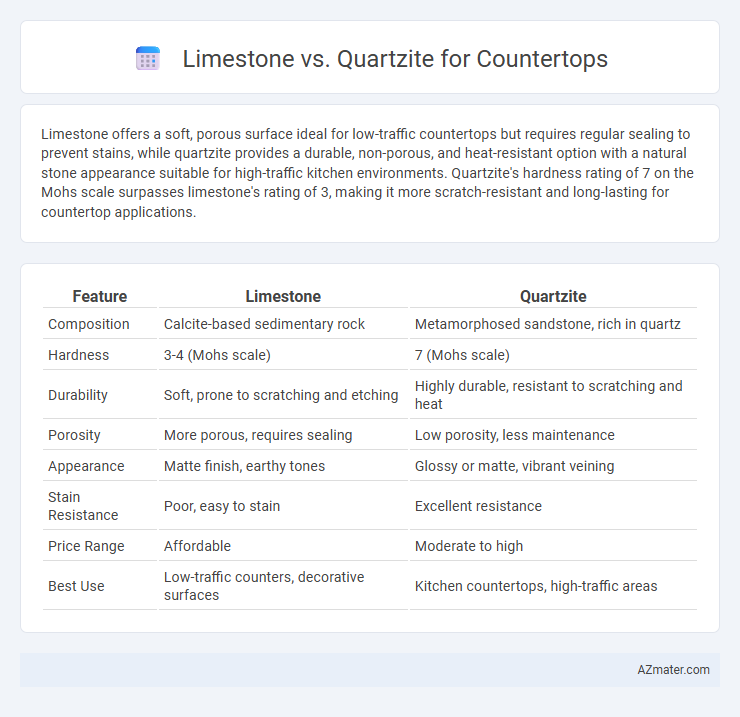Limestone offers a soft, porous surface ideal for low-traffic countertops but requires regular sealing to prevent stains, while quartzite provides a durable, non-porous, and heat-resistant option with a natural stone appearance suitable for high-traffic kitchen environments. Quartzite's hardness rating of 7 on the Mohs scale surpasses limestone's rating of 3, making it more scratch-resistant and long-lasting for countertop applications.
Table of Comparison
| Feature | Limestone | Quartzite |
|---|---|---|
| Composition | Calcite-based sedimentary rock | Metamorphosed sandstone, rich in quartz |
| Hardness | 3-4 (Mohs scale) | 7 (Mohs scale) |
| Durability | Soft, prone to scratching and etching | Highly durable, resistant to scratching and heat |
| Porosity | More porous, requires sealing | Low porosity, less maintenance |
| Appearance | Matte finish, earthy tones | Glossy or matte, vibrant veining |
| Stain Resistance | Poor, easy to stain | Excellent resistance |
| Price Range | Affordable | Moderate to high |
| Best Use | Low-traffic counters, decorative surfaces | Kitchen countertops, high-traffic areas |
Introduction to Limestone and Quartzite Countertops
Limestone countertops offer a natural, sedimentary stone characterized by its softer texture and warm, earthy tones, providing a classic and inviting aesthetic for interiors. Quartzite countertops, formed from metamorphosed sandstone, boast exceptional hardness and durability with a luxurious appearance often resembling marble, making them ideal for high-traffic kitchen surfaces. Both materials present unique benefits in terms of design versatility and maintenance, with quartzite generally being more resistant to scratches and heat compared to limestone.
Composition and Formation Differences
Limestone countertops are primarily composed of calcium carbonate, formed from accumulated marine organisms' shells over millions of years, resulting in a softer, more porous surface. Quartzite, in contrast, is a metamorphic rock formed when sandstone undergoes intense heat and pressure, transforming its quartz-rich composition into a dense, highly durable material. These formation differences influence their durability, porosity, and suitability for various countertop applications.
Appearance and Aesthetic Appeal
Limestone countertops offer a warm, natural look with soft, neutral tones and subtle fossilized patterns that create a timeless, rustic charm. Quartzite provides a more striking visual impact with its crystalline texture, vibrant veining, and a glossy finish that resembles marble, enhancing modern and luxurious kitchen aesthetics. The choice between limestone and quartzite depends on whether a homeowner prefers understated elegance or bold, dynamic beauty in their countertop design.
Durability and Scratch Resistance
Quartzite countertops exhibit superior durability and scratch resistance compared to limestone, making them ideal for high-traffic kitchen environments. Limestone, composed primarily of calcite, is softer and more prone to etching and scratches from knives and abrasive materials. Quartzite's natural hardness, often ranking around 7 on the Mohs scale, provides exceptional resistance to wear, maintaining a pristine surface over time.
Maintenance and Care Requirements
Limestone countertops require regular sealing and gentle cleaning to prevent staining and etching due to their porous and soft nature. Quartzite, a harder and denser natural stone, demands less frequent sealing and is more resistant to scratches, heat, and acids, making maintenance easier. Both materials benefit from non-abrasive cleaners and prompt spill cleanup to preserve surface integrity and appearance.
Stain and Heat Resistance Comparison
Limestone countertops exhibit lower stain resistance due to their porous nature, making them prone to discoloration from acidic substances and oils, whereas quartzite offers superior stain resistance with its dense, non-porous surface. Quartzite also outperforms limestone in heat resistance, tolerating high temperatures without damage, while limestone can suffer etching or discoloration from hot pots or pans. Choosing quartzite enhances durability and longevity in kitchen environments where stain and heat exposure are common.
Cost and Budget Considerations
Limestone countertops generally cost between $50 and $100 per square foot, making them a more budget-friendly option compared to quartzite, which ranges from $70 to $150 per square foot. The affordability of limestone is due to its softer composition and easier quarrying process, but it requires more maintenance and sealing to avoid damage. Quartzite's higher cost reflects its superior durability and resistance to scratches and heat, making it a long-term investment despite the upfront expense.
Installation Process and Challenges
Limestone countertops require careful sealing and gentle handling during installation due to their porous nature and susceptibility to scratching, making grout lines and edge details critical for durability. Quartzite, being harder and more resilient, demands specialized cutting tools and precise skill to avoid chipping or cracking, with installers needing experience in managing its dense structure. Both materials present challenges in weight and fragility during transportation and fitting, but quartzite's durability often balances out its complex installation requirements compared to limestone's ongoing maintenance concerns.
Eco-Friendliness and Sustainability
Limestone and quartzite differ significantly in their eco-friendliness and sustainability as countertop materials. Limestone is a natural sedimentary rock that requires less energy-intensive processing, making it a more environmentally friendly option, but it is softer and may demand more frequent replacement. Quartzite, a metamorphic rock, is highly durable and resistant to wear, reducing the need for replacement over time, yet its extraction and processing often involve higher energy consumption and environmental impact.
Choosing the Right Countertop for Your Needs
Limestone countertops offer a softer, more porous surface, ideal for low-traffic areas and decorative appeal but require regular sealing to prevent stains and scratches. Quartzite provides superior hardness and durability, making it highly resistant to heat, scratches, and acids, suited for high-traffic kitchen environments. Choosing between limestone and quartzite depends on balancing aesthetic preferences with durability needs and maintenance willingness.

Infographic: Limestone vs Quartzite for Countertop
 azmater.com
azmater.com